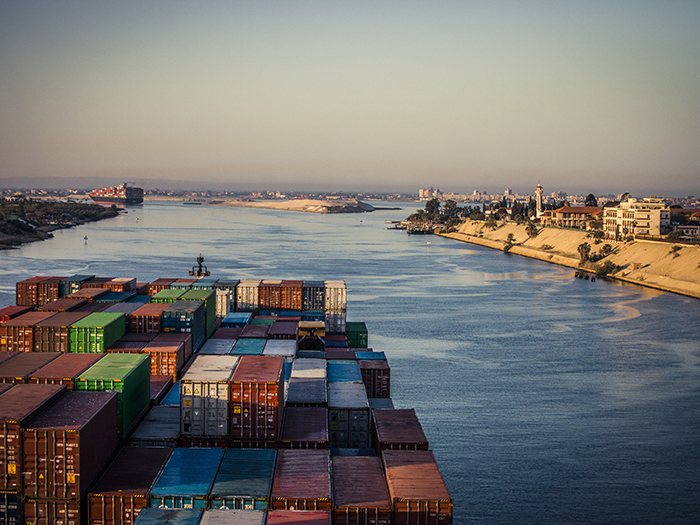An Evergreen Risk: Why This Won’t Be the Last Time the Suez Will Be Blocked by a Megaship

Only a few mistakes are big enough to be seen from space and bring 10% of global trade to a shuddering halt for a week.
So it was on March 23, when the mega-containership Ever Given wedged herself across a one-way section of the Suez Canal in a sandstorm. The vital waterway was completely blocked until March 29, when a spring tide and full moon helped tug boats and excavations refloat the vessel.
When the latest generation of monster ships first took to the seas, maritime risk managers expressed concern about the concentration of risk on one vessel.
And indeed, the International Union of Marine Insurers (IUMI) addressed those very questions in its statement about the Suez blockage: “The trend for larger container vessels has highlighted a number of potential issues such as compromised maneuverability in high winds,” said Richard Turner, president.
“An increasing number of on-board fires, challenges surrounding salvage, and the lack of availability of suitable repair facilities,” are also concerns. “Underwriters need to be aware of this.”
The Ever Given grounded while transiting northbound, with two canal pilots on board, en route to Rotterdam. All 25 crew were reported safe, and there have been no reports of pollution or cargo damage.
From a marine insurance perspective, IUMI suggested that “this incident is unlikely to impact significantly on cargo claims as insurance cover does not usually include delays. Depending on the detail of the policy, insurance is also unlikely to cover damage to cargo caused by a delay. However, if damage caused by delay is included, this might also affect cargo on other vessels impacted by the closure of the canal.”
It is likely to take several weeks for the backlog of vessels to be cleared and normal flow resume, so cargo spoilage remains a possibility.
Across other exposures, IUMI noted that “the relevant hull & machinery (H&M) and cargo interests, or their insurers, will likely be responsible for the cost of the salvage operations and any general average costs that may be incurred. Other claims, including loss of vessel hire or damage to the canal itself are likely to be directed to the protection & indemnity (P&I) or other specialist insurer.”
Megaship Risks Moving Forward
Lars Lange, general secretary of IUMI, told R&I that it will be important for his members as well as vessel owners and operators to collaborate on risk management for the megaships.
“There is no avoiding these vessels,” he said. “The 20,000-TEU ships [as Ever Given is] are in service and the 24,000-TEU vessels are on their way. We have to discuss what this means for risk management.”
Beyond the current focus on the big ships’ increased vulnerability to wind and weather, Lange also noted fire risk and loss of cargo.
“Better firefighting capabilities [on board] is something we are already studying. There is also the problem of lost containers. We are seeing more and more containers lost overboard when the biggest vessels are fully loaded.”
Beyond the ships themselves, he added, the related concerns are salvage capability, vessels and equipment.
Reviewing the Supply Chain
The broadest risk management issue is security of the supply chain. Whether a blizzard in Texas or a sandstorm in Egypt, the narrow focus on minimal inventories that rely upon just-in-time delivery leaves little allowance for weather or accident.
“The fact is that an already heavily disrupted maritime supply chain has taken another hit that will further affect its fluidity, with long-term consequences related to congestions, lead times and predictability,” said Jens Roemer, chair of the Sea Transport Working Group of the International Federation of Freight Forwarders (FIATA).
“We are afraid that effects will not only be limited to the Europe to/from the Far East and Oceania trade lanes, because domino effects cannot be avoided. The situation remains uncertain, and we have no information of substance that would allow for proper planning. We expect shipping lines to adopt demurrage and detention practices that are in line with [published standards] rather than enforcing unfair conditions on other stakeholders.”
FIATA detailed that “many vessels will likely need to re-route around the Cape of Good Hope, adding additional transit times of approximately four to seven days. A likely increase in the speed of the vessels to mitigate the delayed transit times will increase fuel consumption, and this may also incur further container surcharges.”
Even now that the canal is clear, the problems are not over.
“Terminals will experience high congestions and the severe drop in vessel arrival and container discharge in major terminals will aggravate the already ongoing shortages of empty containers available for exports,” FIATA explained. “Already, shipping lines have begun to stop export bookings for affected services. High delays in shipments, increased costs, and product shortages are therefore expected.” &










